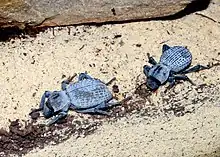| Asbolus verrucosus | |
|---|---|
 | |
| Scientific classification | |
| Domain: | Eukaryota |
| Kingdom: | Animalia |
| Phylum: | Arthropoda |
| Class: | Insecta |
| Order: | Coleoptera |
| Infraorder: | Cucujiformia |
| Family: | Tenebrionidae |
| Genus: | Asbolus |
| Species: | A. verrucosus |
| Binomial name | |
| Asbolus verrucosus | |
Asbolus verrucosus (LeConte, 1852),[2] also known as the desert ironclad beetle or blue death feigning beetle, is a species of darkling beetle native to southwestern United States (southern California to Utah and New Mexico) and northwestern Mexico, where it inhabits dry, sandy habitats such as the Sonoran and Mojave Deserts.[3] It is highly adapted to hot environments and is omnivorous, consuming dead insects, fruits, lichen, and other plant matter.[4] When threatened, the beetles are able to feign death. The species is becoming increasingly popular in the pet trade, due to their ease of care, hardiness, and longevity.

Description
The blue death feigning beetle grows to around 18–21 mm (0.71–0.83 in) from head to abdomen. The species name verrucosus, meaning 'warty', refers to the characteristic bumps on the beetle's elytra. The powdery blue hue of the beetles is due to a wax coating on their bodies that prevents loss of moisture.[5] High humidity darkens the color of the beetles.
Males are slightly smaller than females, and have bristly red hairs on their antennae. The beetles are crepuscular, being most active at dawn and dusk.
Captivity
The majority of captive beetles are wild-caught, but suit very well in captivity. Care requirements are minimal, as the beetles do not require extensive humidity or heating regulation, and only require sandy substrate and hides to rest under. The beetles are unable to climb on smooth surfaces (plastic or glass), and their diets are extremely diverse—they can be fed vegetables, fruits, lichen, shrimp, dead insects, as well as dog and cat foods. Blue death feigning beetles have been successfully kept with desert hairy scorpions and/or velvet ants,[6] and are well suited to communal arrangements.
Current research
In 2015, the complete mitochondrial genome of the desert darkling beetle was sequenced,[7] funded by the Blue Beetle Genome Project. As of 2015, it was the first fully assembled mitogenome sequence for a darkling beetle in the subfamily Pimeliinae.
The blue death feigning beetle is notoriously difficult to breed in captivity and rear to adulthood; in 2018, researchers at the Cincinnati Zoo were able to rear their first adult beetle after beginning breeding in 2014.[8] Hobbyists have publicly documented their experience with successfully breeding their beetles, noting issues with maintaining proper humidity and heating required for larvae to pupate.[9]
References
- ↑ "Asbolus verrucosus". Uniprot.org.
- ↑ Annals of the Lyceum of Natural History of New York. Vol. 5. New-York. 1852 – via Biodiversitylibrary.org.
{{cite book}}: CS1 maint: location missing publisher (link) - ↑ "Species Asbolus verrucosus". BugGuide. Retrieved 27 June 2023.
- ↑ "Archived copy" (PDF). Archived from the original (PDF) on 2015-12-22. Retrieved 2015-12-22.
{{cite web}}: CS1 maint: archived copy as title (link) - ↑ "Centrioptera Mannerheim 1843 - Encyclopedia of Life". Eol.org.
- ↑ Archived at Ghostarchive and the Wayback Machine: Blue Death-Feigning Beetle, The Best Invertebrate?. YouTube.
- ↑ Rider, Stanley Dean Jr. (2016-07-03). "The complete mitochondrial genome of the desert darkling beetle Asbolus verrucosus (Coleoptera, Tenebrionidae)". Mitochondrial DNA Part A. 27 (4): 2447–2449. doi:10.3109/19401736.2015.1033692. ISSN 2470-1394. PMID 26016880. S2CID 356155.
- ↑ "This beetle plays dead better than a possum". WCPO. 2018-09-25. Retrieved 2021-04-01.
- ↑ "Blue Death-Feigning Beetle Breeding Project - YouTube". Youtube.com. Retrieved 2021-04-01.